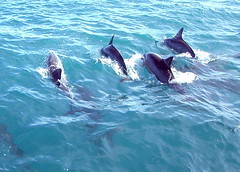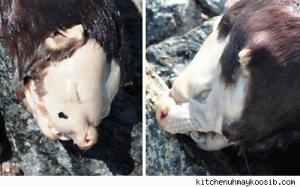This is fascinating and bizarre. Below are pictures of what the human body would look like if each part was proportioned according to the area of the brain concerned with that part’s motor control and sensory perception, respectively. In other words, our brains devote considerably larger areas to the sensory perception and motor control of the hands, say, th
 an a random patch of skin on the back. Note how the motor homunculus is almost entirely hand and mouth – makes sense. (From the London Natural History Museum.)
an a random patch of skin on the back. Note how the motor homunculus is almost entirely hand and mouth – makes sense. (From the London Natural History Museum.)
Category: Uncategorized
Dolphin species attempt “common language”

Image by jurvetson via Flickr
We bring you the latest news in animal cognition:
When two dolphin species come together, they attempt to find a common language, preliminary research suggests.
Bottlenose
and Guyana dolphins, two distantly related species, often come together
to socialise in waters off the coast of Costa Rica.Both species
make unique sounds, but when they gather, they change the way they
communicate, and begin using an intermediate language.That raises the possibility the two species are communicating in some way.
See the rest of this article here!
Surprisingly banned books
Our friend Olivia points out this odd list of unexpectedly banned books. She writes,
Some of these books, not so surprising. But others? Oh yeah.
Seems that creativity and imagination are synonymous with “satanism”.
And the banning of a dictionary, I mean really?
Giant squid multiplying, attacking humans
The mariners’ tales of yore are coming to life, it seems. Take a look at this harrowing story from The Daily Express:
Millions of killer giant squid are not only devouring vast amounts of fish they have even started attacking humans.
Two
Mexican fishermen were recently dragged from their boats and chewed so
badly that their bodies could not be identified even by their own
families.No wonder the giant squid are called “diablos rojos” – red devils.
You can read more here.
Opossums, introduced to fight rats, overrun Brooklyn
Talk about good intentions gone wrong:
Apparently the eye scanners from Minority Report are now a reality.

Image by jterning via Flickr
From USA Today:
The Homeland Security Department plans to test futuristic iris scan
technology that stores digital images of people’s eyes in a database and
is considered a quicker alternative to fingerprints.Iris scanners are little used, but a new generation of cameras that
capture images from 6 feet away instead of a few inches has sparked
interest from government agencies and financial firms, said Patrick
Grother, a National Institute of Standards and Technology computer
scientist.
This could be interesting. As long as the technology isn’t abused or overused, it certainly seems like it could have valid applications – but who knows how it’ll actually turn out. I’m not looking forward to personalized holographic advertisements that track you by your irises, though.
Link submitter up
Dear loyal friends and readers,
Adverbly.net now boasts a submission form. If you’ve got suggestions for stories or links you’d like us to post – if you’ve come across anything strange, creepy, or uncanny on the internet that you feel is worth sharing – you can use the suggest a link form to let us know about it (see also the menu on the right).
Undersea river discovered
Scientists recently discovered the sixth largest river in the world. How did the world’s sixth largest river manage to remain undetected for so long? As it turns out, it’s at the bottom of the ocean.
Researchers working in the Black Sea have found currents of water 350 times
greater than the River Thames flowing along the sea bed, carving out
channels much like a river on the land.
The undersea river, which is up to 115ft deep in places, even has rapids and
waterfalls much like its terrestrial equivalents.
The scientists, based at the University of Leeds, used a robotic submarine to
study for the first time a deep channel that had been found on the sea bed.
They found a river of highly salty water flowing along the deep channel at the
bottom of the Black Sea, creating river banks and flood plains much like a
river found on land.
Dr Dan Parsons, from the university’s school of earth and environment, said: “The
water in the channels is denser than the surrounding seawater because it has
higher salinity and is carrying so much sediment.
You can find more information here.
“Solar tsunami” headed for earth

Image via Wikipedia
Brace yourselves, world – things are gonna get sunny, and not in a good way. Astronomers have witnessed a massive explosion on the surface of the sun – a solar flare – and are tracking its progress as it races towards the outer layers of our atmosphere.
Experts said the wave of supercharged gas will likely reach the Earth on
Tuesday, when it will buffet the natural magnetic shield protecting Earth.
It is likely to spark spectacular displays of the aurora or northern and
southern lights.
“This eruption is directed right at us,” said
Leon Golub, of the Harvard-Smithsonian Center for Astrophysics
(CfA).
“It’s the first major Earth-directed eruption in quite some time.”
Scientists have warned that a really big solar eruption could destroy
satellites and wreck power and communications grids around the globe if it
happened today.
While it’s impossible to predict the exact effects of this eruption, it is certainly possible that it will disrupt communications in some areas. The article, which you can read here, notes that NASA “recently warned that Britain could face widespread power blackouts and be
left without critical communication signals for long periods of time, after
the earth is hit by a once-in-a-generation ‘space storm.'”
This is particularly troubling, of course, because we are believed to be in a period of subdued solar activity that is scheduled to end – explosively – in 2013. If a flare like this one is “subdued,” I’d hate to see what’s coming our way in ’13.
UPDATE: You can see pictures of this solar flare, and find more information, at NASA’s website.
Earthquake rattles New York
From the Huffington Post:
An earthquake that hit parts of Canada earlier today rocked the New
York City area, as well.The 5.5 magnitude quake in Southern Ontario could be felt as far
south as Brooklyn and Staten Island. Parts of New Jersey and upstate
New York, including Buffalo, were also affected.Rochester’s 13WHAM-TV newsroom reported feeling “shaking” that lasted “for about 5
to 10 seconds.”There are no reports of injuries at this time.
Moths drink the tears of sleeping birds
That sounds at once quasi-poetic and somewhat disturbing. But apparently it’s true. There exists a species of moth in Madagascar that sups on the tears of birds:
A species of moth drinks tears from the eyes of
sleeping birds using a fearsome proboscisshaped like a harpoon,
scientists have revealed. The new discovery – spied in Madagascar – is
the first time moths have been seen feeding on the tears of birds.Roland Hilgartner at the German Primate Centre in Göttingen, Germany, and Mamisolo Raoilison Hilgartner
at the University of Antananarivo in Madagascar, witnessed the
apparently unique sight in the island state’s Kirindy forest.
If this is not weird enough, apparently
Tear-feeding moths and butterflies are known to exist elsewhere in
Africa, Asia and South America, but they mainly feed on large, placid
animals, such as deer, antelope or crocodiles, which cannot readily
brush them away. But there are no such large animals on Madagascar. The
main mammals – lemurs and mongoose – have paws capable of shooing the
moths. Birds can fly away.
You can read more here.
Strange creature discovered in Ontario Creek
 Ever since the Montauk Monster controversy, I’m more skeptical of this sort of thing than I used to be (which probably brings me to a normal level of skepticism, overall). Nevertheless, if this isn’t a hoax, it’s certainly quite creepy. From AolNews:
Ever since the Montauk Monster controversy, I’m more skeptical of this sort of thing than I used to be (which probably brings me to a normal level of skepticism, overall). Nevertheless, if this isn’t a hoax, it’s certainly quite creepy. From AolNews:
TORONTO – A First Nations community in northern Ontario may be
giving Loch Ness a run for its money.Reports from the remote
community a few hundred kilometres south of Hudson Bay say a strange
creature was pulled from a local creek earlier this month – a creature
some are calling a monster.
[…]
According to the website, two local nurses were hiking near the creek
when they noticed their dog Sam sniffing something in the water.The
dog pulled the 30-centimetre-long dead creature from the water and the
two women snapped some photos of it.
You can read more here.


